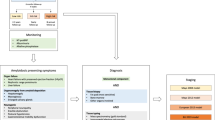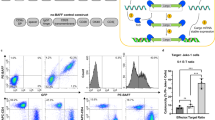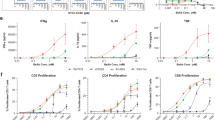Abstract
Patients with immunoglobulin (Ig) light-chain (LC) diseases such as LC light-chain amyloidosis die with organ failure and need new therapies. We sought a model to test anti-LC siRNA delivery to human plasma cells, requiring circulating LC, in vivo indicators of tumor presence, and capacity for multiple injections of delivery vehicle. The JJN-3 human myeloma reporter cell line expressing firefly luciferase (FFL) implanted intraperitoneally (IP) in the NOD scid γ (NSG) mouse has a 90% prompt tumor-take, rapid LC production, and in vivo indicators of tumor measurable on day 5 post-implant (κ LC, bioluminescent signal, and soluble B-cell maturation antigen [sBCMA]) with median day 5 serum levels of κ LC of 1482 ng/mL (range, 255–4831) and robust correlations with all in vivo indicators. In preliminary attempts to deliver siRNA against κ LC constant region mRNA, we identified the 306-O18B3 lipidoid nanoparticle (LNP) as promising, safe and efficient in vitro. In vivo in the JJN-3 NSG IP model, after daily IP 306-O18B3:siRNA injections on days 5–10, a reduction in κ LC was observed on day 8 between control and test groups that continued through day 12 at sacrifice. This model is potentially useful as a platform for refining anti-LC therapies.
This is a preview of subscription content, access via your institution
Access options
Subscribe to this journal
Receive 12 print issues and online access
$259.00 per year
only $21.58 per issue
Buy this article
- Purchase on Springer Link
- Instant access to full article PDF
Prices may be subject to local taxes which are calculated during checkout





Similar content being viewed by others
References
Muchtar E, Gertz MA, Kumar SK, Lacy MQ, Dingli D, Buadi FK, et al. Improved outcomes for newly diagnosed AL amyloidosis between 2000 and 2014: cracking the glass ceiling of early death. Blood. 2017;129:2111–9.
Jaccard A, Comenzo RL, Hari P, Hawkins PN, Roussel M, Morel P, et al. Efficacy of bortezomib, cyclophosphamide and dexamethasone in treatment-naive patients with high-risk cardiac AL amyloidosis (Mayo Clinic stage III). Haematologica. 2014;99:1479–85.
Hussain AS, Hari P, Brazauskas R, Arce-Lara C, Pasquini M, Hamadani M, et al. Changes in cardiac biomarkers with bortezomib treatment in patients with advanced cardiac amyloidosis. Am J Hematol. 2015;90:E212–3.
Dispenzieri A, Kyle R, Merlini G, Miguel JS, Ludwig H, Hajek R, et al. International Myeloma Working Group guidelines for serum-free light chain analysis in multiple myeloma and related disorders. Leukemia. 2009;23:215–24.
Comenzo RL, Reece D, Palladini G, Seldin D, Sanchorawala V, Landau H, et al. Consensus guidelines for the conduct and reporting of clinical trials in systemic light-chain amyloidosis. Leukemia . 2012;26:2317–25.
Palladini G, Dispenzieri A, Gertz MA, Kumar S, Wechalekar A, Hawkins PN, et al. New criteria for response to treatment in immunoglobulin light chain amyloidosis based on free light chain measurement and cardiac biomarkers: impact on survival outcomes. J Clin Oncol. 2012;30:4541–9.
Bradwell AR. Serum free light chain measurements move to center stage. Clin Chem. 2005;51:805–7.
Wong SW, Toskic D, Warner M, Varga C, Moreno-Koehler A, Fein D, et al. Primary Amyloidosis with renal involvement: outcomes in 77 consecutive patients at a single center. Clin Lymphoma Myeloma Leuk. 2017;17:759–66.
Landau H, Smith M, Landry C, Chou JF, Devlin SM, Hassoun H, et al. Long-term event-free and overall survival after risk-adapted melphalan and SCT for systemic light chain amyloidosis. Leukemia. 2017;31:136–42.
Ma X, Zhou P, Wong SW, Warner M, Chaulagain C, Comenzo RL. siRNA targeting the kappa light chain constant region: preclinical testing of an approach to nonfibrillar and fibrillar light chain deposition diseases. Gene Ther. 2016;23:727–33.
Zhou P, Ma X, Iyer L, Chaulagain C, Comenzo RL. One siRNA pool targeting the lambda constant region stops lambda light-chain production and causes terminal endoplasmic reticulum stress. Blood. 2014;123:3440–51.
Hovey BM, Ward JE, Soo Hoo P, O’Hara CJ, Connors LH, Seldin DC. Preclinical development of siRNA therapeutics for AL amyloidosis. Gene Ther. 2011;18:1150–6.
Phipps JE, Kestler DP, Foster JS, Kennel SJ, Donnell R, Weiss DT, et al. Inhibition of pathologic immunoglobulin-free light chain production by small interfering RNA molecules. Exp Hematol. 2010;38:1006–13.
Ward JE, Ren R, Toraldo G, Soohoo P, Guan J, O’Hara C, et al. Doxycycline reduces fibril formation in a transgenic mouse model of AL amyloidosis. Blood. 2011;118:6610–7.
Ball RL, Hajj KA, Vizelman J, Bajaj P, Whitehead KA. Lipid nanoparticle formulations for enhanced co-delivery of siRNA and mRNA. Nano Lett. 2018;18:3814–22.
Badros AZ, Goloubeva O, Rapoport AP, Ratterree B, Gahres N, Meisenberg B, et al. Phase II study of G3139, a Bcl-2 antisense oligonucleotide, in combination with dexamethasone and thalidomide in relapsed multiple myeloma patients. J Clin Oncol. 2005;23:4089–99.
Bataille R, Grenier J, Sany J. Beta-2-microglobulin in myeloma: optimal use for staging, prognosis, and treatment—a prospective study of 160 patients. Blood. 1984;63:468–76.
Boccadoro M, Gallone G, Frieri R, Pileri A, Bataille R, Klein B. Plasma cell labeling index, beta 2-microglobulin, and C-reactive protein: what is the best combination for myeloma prognosis? Blood. 1993;82:3507–8.
Carpenter RO, Evbuomwan MO, Pittaluga S, Rose JJ, Raffeld M, Yang S, et al. B-cell maturation antigen is a promising target for adoptive T-cell therapy of multiple myeloma. Clin Cancer Res. 2013;19:2048–60.
Tai YT, Mayes PA, Acharya C, Zhong MY, Cea M, Cagnetta A, et al. Novel anti-B-cell maturation antigen antibody-drug conjugate (GSK2857916) selectively induces killing of multiple myeloma. Blood. 2014;123:3128–38.
Ghermezi M, Li M, Vardanyan S, Harutyunyan NM, Gottlieb J, Berenson A, et al. Serum B-cell maturation antigen: a novel biomarker to predict outcomes for multiple myeloma patients. Haematologica. 2017;102:785–95.
Laurent SA, Hoffmann FS, Kuhn PH, Cheng Q, Chu Y, Schmidt-Supprian M, et al. gamma-Secretase directly sheds the survival receptor BCMA from plasma cells. Nat Commun. 2015;6:7333.
Ball RL, Knapp CM, Whitehead KA. Lipidoid nanoparticles for siRNA delivery to the intestinal epithelium: in vitro investigations in a Caco-2 model. PLoS ONE. 2015;10:e0133154.
Xu Q, Ensign LM, Boylan NJ, Schon A, Gong X, Yang JC, et al. Impact of surface polyethylene glycol (PEG) density on biodegradable nanoparticle transport in mucus ex vivo and distribution in vivo. ACS Nano. 2015;9:9217–27.
Zhao H, Doyle TC, Coquoz O, Kalish F, Rice BW, Contag CH. Emission spectra of bioluminescent reporters and interaction with mammalian tissue determine the sensitivity of detection in vivo. J Biomed Opt. 2005;10:41210.
Wang M, Alberti K, Varone A, Pouli D, Georgakoudi I, Xu Q. Enhanced intracellular siRNA delivery using bioreducible lipid-like nanoparticles. Adv Healthc Mater. 2014;3:1398–403.
Li Y, Bolinger J, Yu Y, Glass Z, Shi N, Yang L, et al. Intracellular delivery and biodistribution study of CRISPR/Cas9 ribonucleoprotein loaded bioreducible lipidoid nanoparticles. Biomater Sci. 2018;75:96–606.
Wang M, Zuris JA, Meng F, Rees H, Sun S, Deng P, et al. Efficient delivery of genome-editing proteins using bioreducible lipid nanoparticles. Proc Natl Acad Sci USA. 2016;113:2868–73.
Jagannath S. Value of serum free light chain testing for the diagnosis and monitoring of monoclonal gammopathies in hematology. Clin Lymphoma Myeloma. 2007;7:518–23.
Gooding RP, Bybee A, Cooke F, Little A, Marsh SG, Coelho E, et al. Phenotypic and molecular analysis of six human cell lines derived from patients with plasma cell dyscrasia. Br J Haematol. 1999;106:669–81.
Dejoie T, Attal M, Moreau P, Harousseau JL, Avet-Loiseau H. Comparison of serum free light chain and urine electrophoresis for the detection of the light chain component of monoclonal immunoglobulins in light chain and intact immunoglobulin multiple myeloma. Haematologica. 2016;101:356–62.
Reece DE, Sanchorawala V, Hegenbart U, Merlini G, Palladini G, Fermand JP, et al. Weekly and twice-weekly bortezomib in patients with systemic AL amyloidosis: results of a phase 1 dose-escalation study. Blood. 2009;114:1489–97.
Acknowledgements
For their continued support, we thank the Division of Hematology-Oncology and Departments of Medicine and Pathology and Laboratory Medicine at Tufts, the Amyloidosis and Myeloma Research Fund at Tufts, the Cam Neely and John Davis Myeloma Research Fund, the John C. Davis Program for Myeloma and Amyloid at Tufts, the Sidewater Family Fund, the Lavonne Horowitz Trust, the Werner and Elaine Dannheiser Fund for Research on the Biology of Aging of the Lymphoma Foundation, David and Barbara Levine (in memoriam), and the Demarest Lloyd Jr Foundation.
Author information
Authors and Affiliations
Corresponding author
Ethics declarations
Conflict of interest
Drs Comenzo, Ma, and Zhou have a patent on the siRNA sequences used to knock down expression of the κ light chain constant region. Dr Comenzo has served as a consultant or advisor to Takeda Millennium, Unum, Prothena and Janssen, and has received clinical research funding from Takeda Millennium, Janssen, and Prothena Biotech. Drs Xu and Wang have numerous patents on nanostructure delivery vehicles. The remaining authors declare that they have no conflict of interest.
Additional information
Publisher’s note: Springer Nature remains neutral with regard to jurisdictional claims in published maps and institutional affiliations.
Supplementary information
Rights and permissions
About this article
Cite this article
Ma, X., Zhou, P., Kugelmass, A. et al. A novel xenograft mouse model for testing approaches targeting human kappa light-chain diseases. Gene Ther 26, 187–197 (2019). https://doi.org/10.1038/s41434-019-0070-y
Received:
Revised:
Accepted:
Published:
Issue Date:
DOI: https://doi.org/10.1038/s41434-019-0070-y



